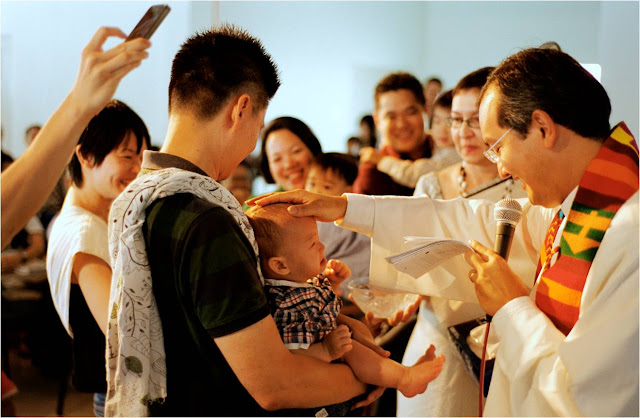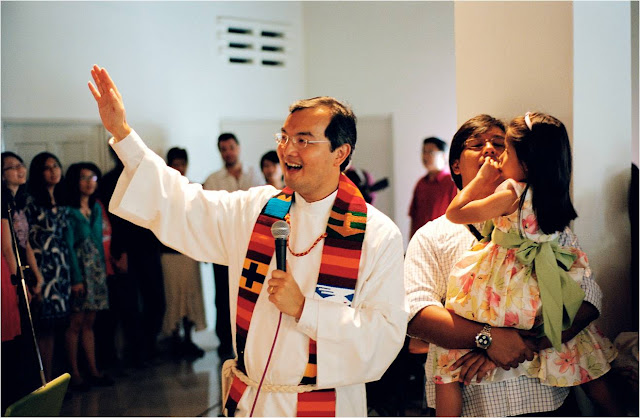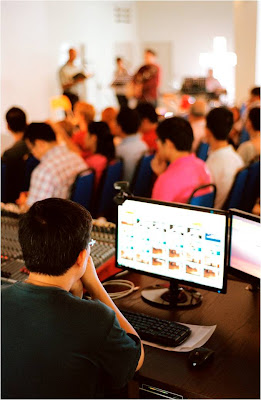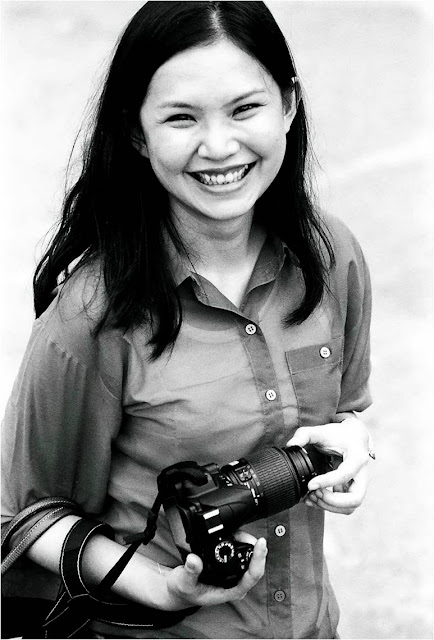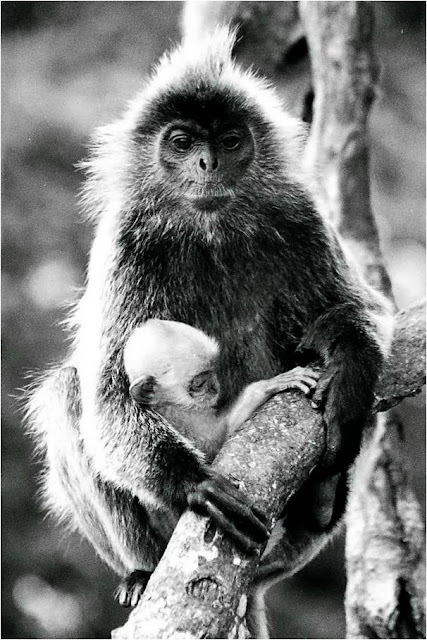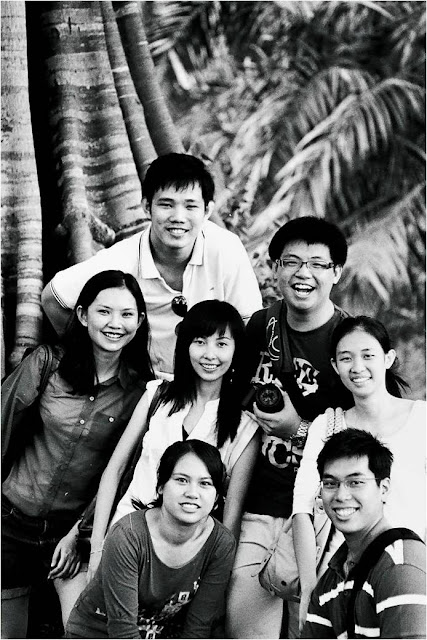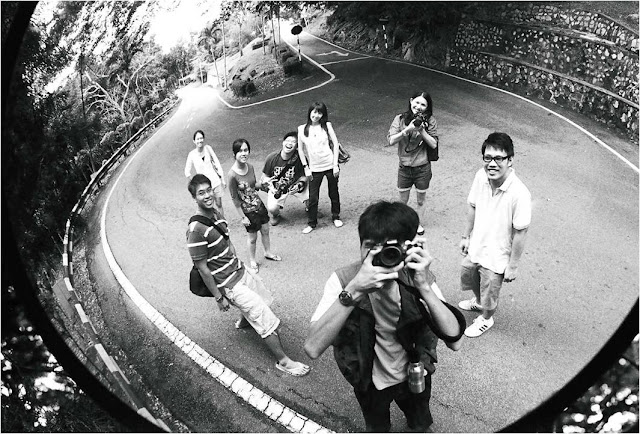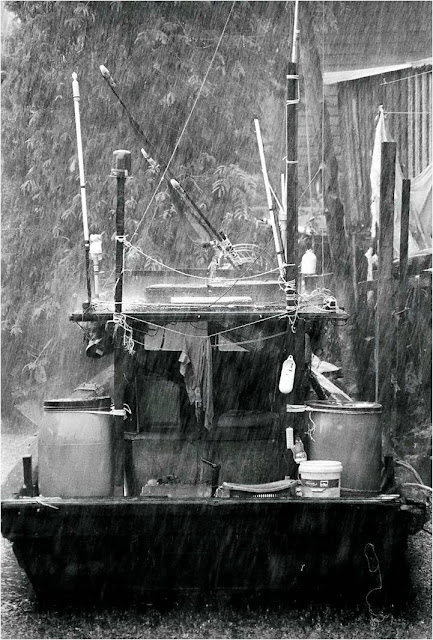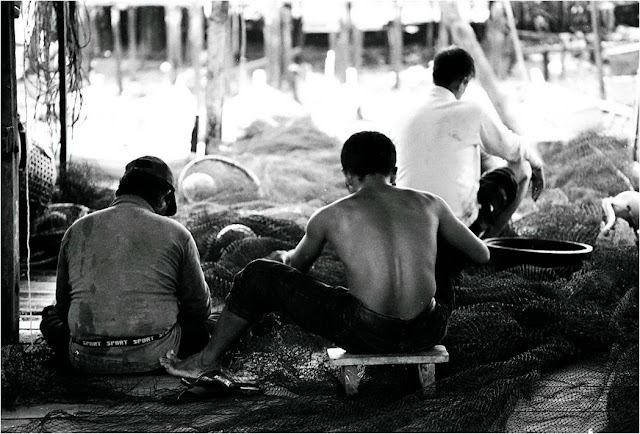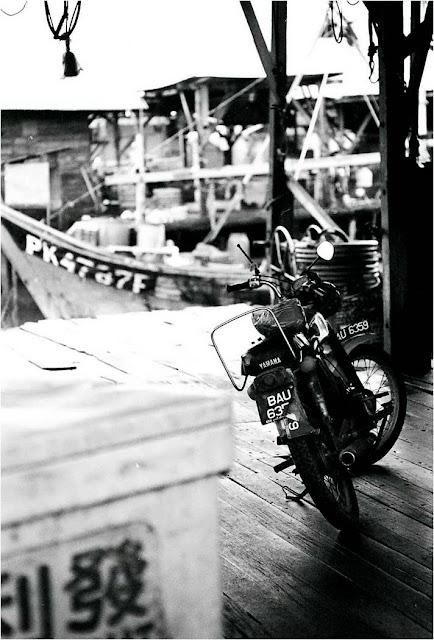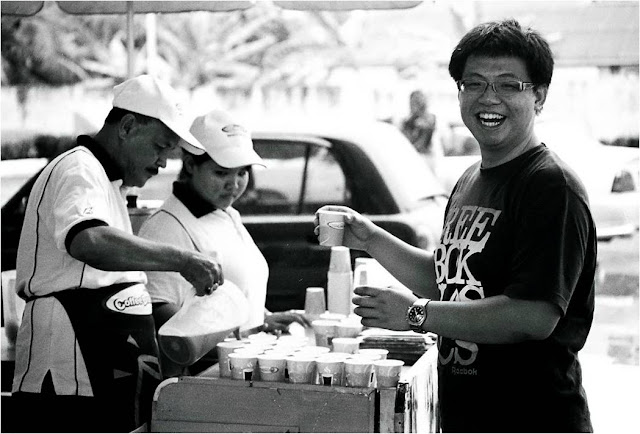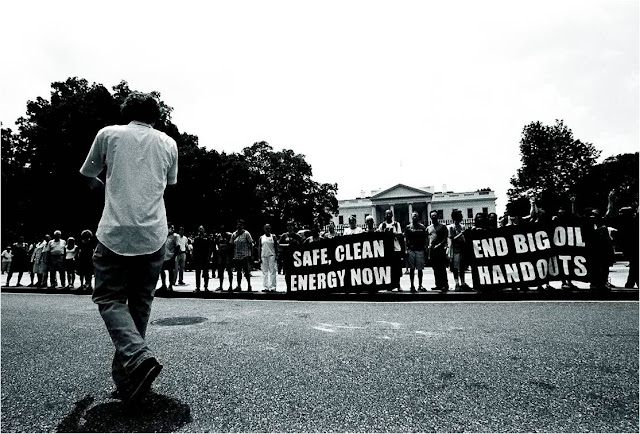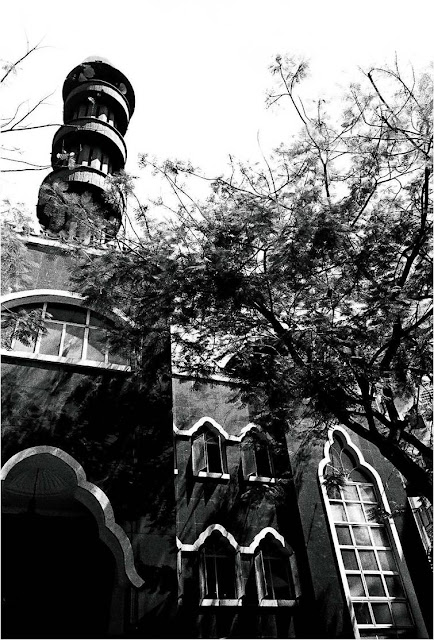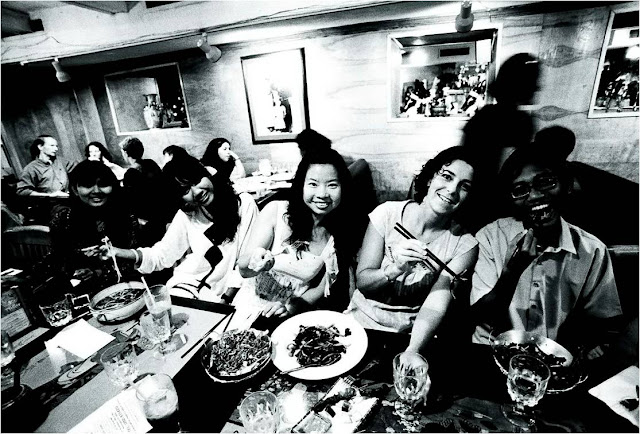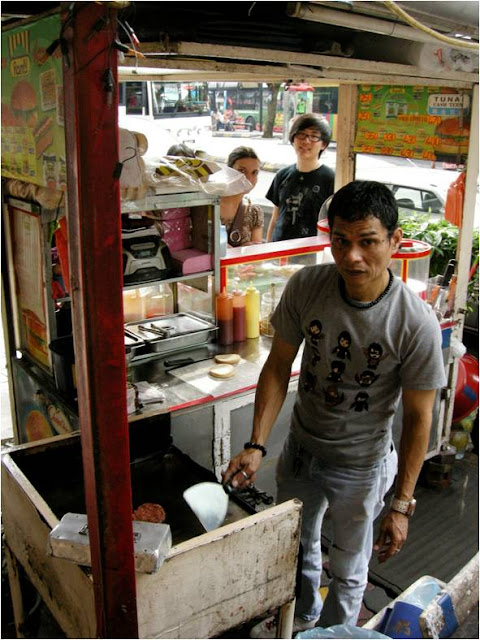It's important to recognise those times when it isn't worth your while taking a picture at all. That is rarely the location's fault and is usually down to the photographer.
You might go somewhere and not make any photographs, but return a few months later and see images everywhere. The location hasn't changed, but the photographer has.
-- Travel Photography Masterclass, Ailsa McWhinnie (ed.)
Saturday, February 19, 2011
Monday, February 14, 2011
Sivin's Last Bow
I don't think this is Sivin's last bow in the Sherlock Holmes's last bow was his last recorded adventure. But it is nevertheless a very significant hiatus after ten years of momentum-gaining ministry inside and out of BLC.
But first... we're back at The Father's House, 23 Jalan Abdullah, Bangsar!
Celebrating the Eucharist with Dr Phil, 5 December 2010; first Sunday back at the renovated premises.
The Anderbecks on the front façade.
* * *
Christmas 2010 was Sivin's last official outing as the pastor of BLC, and he went out with all the gestures and nuances that have come to define him thus far.
Sheryl and Leigh led worship.
The crosses in the walls were maintained, now occupying a more prominent position with portions of the walls removed.
Rama, the 'voice of God', reading Scripture. He was chief of the building committee.
Sivin used to say that "Jesus sat while he taught", and so he felt entitled to do the same. To date, he's the only 'sitting pastor' I have ever met.
Reciting the Apostles' Creed at the children's baptism.
Sivin baptising Joash... or is that Jaden? Even Daddy Larry got mixed up that morning! ;-)
Delivering his final 'official' benediction at the customary service-ending BLC circle.
Sivin, Rama, Judith, Wolfgang... and a now-liberated Aung San Suu Kyi.
Christmas we celebrated with those whose names are neither known nor recognised by the powers that be, but who are loved beyond words can describe by the Power that is, was, and evermore shall be. The Father sent the Son, and so the Son sent us.
* * *
Sivin may have left (for a couple of months anyway), but he remains connected in more ways than one.
Yu Chiet watching over the new media system which allows live video telecast of services; NOT an excuse for members to 'spectate' from the comfort of home!
At least Sivin can watch us, if he so wishes, at 3.00 a.m. in Kristiansand, Norway.
The family who will soon join him: May Chin, Gareth, Elysia, Ewan... and Number Four!
* * *
(Colour pictures shot on Kodak Portra 400VC. Black-and-whites on Kodak Tri-X 400. 50mm lens.)
But first... we're back at The Father's House, 23 Jalan Abdullah, Bangsar!
Celebrating the Eucharist with Dr Phil, 5 December 2010; first Sunday back at the renovated premises.
The Anderbecks on the front façade.
* * *
Christmas 2010 was Sivin's last official outing as the pastor of BLC, and he went out with all the gestures and nuances that have come to define him thus far.
Sheryl and Leigh led worship.
The crosses in the walls were maintained, now occupying a more prominent position with portions of the walls removed.
Rama, the 'voice of God', reading Scripture. He was chief of the building committee.
Sivin used to say that "Jesus sat while he taught", and so he felt entitled to do the same. To date, he's the only 'sitting pastor' I have ever met.
Reciting the Apostles' Creed at the children's baptism.
Sivin baptising Joash... or is that Jaden? Even Daddy Larry got mixed up that morning! ;-)
Delivering his final 'official' benediction at the customary service-ending BLC circle.
Sivin, Rama, Judith, Wolfgang... and a now-liberated Aung San Suu Kyi.
Christmas we celebrated with those whose names are neither known nor recognised by the powers that be, but who are loved beyond words can describe by the Power that is, was, and evermore shall be. The Father sent the Son, and so the Son sent us.
* * *
Sivin may have left (for a couple of months anyway), but he remains connected in more ways than one.
Yu Chiet watching over the new media system which allows live video telecast of services; NOT an excuse for members to 'spectate' from the comfort of home!
At least Sivin can watch us, if he so wishes, at 3.00 a.m. in Kristiansand, Norway.
The family who will soon join him: May Chin, Gareth, Elysia, Ewan... and Number Four!
* * *
(Colour pictures shot on Kodak Portra 400VC. Black-and-whites on Kodak Tri-X 400. 50mm lens.)
Wednesday, February 09, 2011
Back to Black-and-White
When I saw this photo on Ken Rockwell's site, and when I read on the first page that he'd used a Leica M9 (digital) rangefinder for the Route 66 trip, editing in Apple Aperture 3, I thought, "Wow, digital is getting really good!"
I knew you could transform digital files into film lookalikes in Photoshop and Aperture, but this came a little too close for comfort. And then, as I read through the article, I realised it was actually film all along; Ken used the M9 for the colour pictures, but an M3 loaded with Agfa APX 100 for the black-and-whites.
So there we have it: when it comes to silver halide contrast and texture, there's still nothing like the real thing!
Read the full piece here.
Collected Thoughts on Photography
Some collected thoughts on photography, since December last year.
Nikon P7000 vs Canon EOS 60D
In the December 2010 issue of National Geographic, Nikon ran an advertisement for its flagship compact camera, the semi-pro P7000:
Some four pages away, Canon's featured its semi-pro DSLR:
The comparison could not be more disproportionate. But then perhaps Nikon has the better understanding of the National Geographic spirit in this one. After all, which camera is likely to enable the photographer to travel further and wider?
Back in the heyday of Cartier-Bresson and company, the 35mm rangefinder was the definitive tool-of-the-trade. It's not hard to understand why: the lightweight rangefinders were a lot less intrusive than large-format press cameras.
Today, there are no compact cameras with equivalent performance to DSLRs in terms of speed and overall handling, and there are no affordable digital rangefinders (the Leica M9 costs a bomb). I have toyed around with the P7000, and it seems that a D3100 (Nikon's smallest DSLR to date) is a much better bet. I have yet to try out the Olympus PEN system, but that might be the best compromise for performance of DSLR-standards in a compact.
Still, that ad from Nikon was a good reminder of what photography is all about: getting out there and being in the right place, at the right time. Galen Rowell would've loved the P7000 I think.
* * *
Further Thoughts on Film
I have time and again shared the reasons behind my preference for film. Here I would just like to dwell on three ideas: legibility, simplicity and character.
Ken Rockwell said it, and I cannot help but agree: with film you don't need any software to read the photograph. Don't get me wrong: I love working with my RAW files when utmost quality is needed, but even RAW files get illegible sometimes. I couldn't read Doulos's D60 RAW files on my first-edition Capture NX software. Programmes like Photoshop need to be updated from time to time in order to be compatible with the latest RAW firmware, etc.
In contrast, there is no risk of film shot today being illegible decades from now, as long as there is light and humans have eyes.
What, then, of chemicals? Unlike proprietary algorithms employed in RAW, chemical development methods like E-6, C-41 and silver halide processing, are available to anyone and everyone. While some of these chemicals are no longer manufactured en masse, the workings behind them will be readily apparent to anyone trained in the chemical sciences.
On simplicity, I read this article on Photojojo's 'Ultra Wide and Slim' camera page (link here):
Remember when all it took was a roll of film and a trip to 1 hour photo?
Now that we've gone digital, we spend hours in Photoshop, pore over 300 page camera manuals, and spend our life's savings on photo gadgets we don't even know how to use. We kind of love it, most of time.
But sometimes we wonder, what happened to simplicity?
I looked the camera up because Nasha's brother had given her one for Christmas, which means she now has two 'old school' film cameras, the Recesky 'twin lens' and now this. Can't wait to go out shooting with her, really.
And finally, character.
I think the reason people shoot film, is because of the particular character of different types of films. You are not just a 'film' photographer. You are a Velvia, or a Kodachrome, or a Tri-X photographer. You use film because of the character and look imparted by these stocks.
The masses have moved to digital because, in many ways, digital does a better job of reproducing colours accurately and more effortlessly than consumer films (the sort you get in supermarkets and in the everyday photo shops).
But the art and landscape photographers, who care less for accuracy than for mood, like how film exaggerates and gives its own spin on colours and tones. You can probably design an algorithm to replicate these stocks in Photoshop; or you could do the easy thing and go out there and shoot. You could convert to black-and-white, add grain and play around with contrast levels, but it just wouldn't be the same as working on a roll of Tri-X in the darkroom.
* * *
On Attitudes in Photography
Meet Timothy Wooi, photographer and social worker from Kedah. We encountered him at the restaurant in Kuala Perlis during the LAB Tour (more on that to come), and he gave us a lecture on photography against the setting sun.
One of the things I struggle with is talking to strangers. Being naturally an introvert, I don't mingle very easily. On this occasion, as with Alex Powers, it was the other person who made the first move.
I have come to learn that it pays to make friends, to talk to the people you meet; they are more likely to pose for you and share what they know about the place you're visiting, especially if you're foreign to it. Of course there is a risk when making contact with strangers, but given a healthy dose of discretion and wisdom, an open attitude towards the locals in a strange land can prove more beneficial than not.
* * *
On Lighting and Composition
In this Outdoor Photographer article, Adam Barker writes;
If we could bottle up the light that blesses most of our five-star imagery, we could sell it for billions of dollars a bottle—that’s how good the light is that we crave most.
Where do we find this light? We find it in the early and late hours. We find it when most other sane individuals are warm in their beds or swishing their glass of evening wine. You must be committed to getting up early and staying out late.
[...]
I believe that composition is the rawest demonstration of a photographer’s ability to create. Subject matter is most often already existent. Light can be happened upon. Composition, however, is entirely dependent upon the artist’s intrinsic ideal. It’s the outward arrangement of an inward vision.
I recall that many of my best photographs were made early in the morning and late into the evening. But more so, they were made when it was considered inconvenient to do so; when lunch or dinner was more tempting, or when the rain was too intimidating.
I recall also, something Eric Peris said when we visited him about a year ago, about composition. He would look at something, and if the composition wasn't working for him he would say it was because he didn't understand the elements in that prospective photograph, and he would walk away and maybe come back to it later. Perhaps he would then understand the elements and be better able to produce a satisfactory composition.
There is something in this more contemplative approach to photography that is missing in today's 'shoot first, think later' (or don't think at all) attitude. I suppose that is why landscape photographers still haul their large-format gear and bulky tripods into impossible terrain: it makes them take only the really great pictures, as it would not be worth the effort to set up for a mere snapshot.
* * *
Where To, From Here?
And now this is the part that matters most. Seven years of photography, four-and-a-half of those with the DSLR, and three of them with the addition of film; the big question is, where to from here?
I find it hard to let go of my lenses.
I have some eight lenses or so, and it might seem an intimidating amount (by today's standards), but most of these lenses were purchased cheap off the second-hand market. The total worth of all my lenses would barely buy you a pro lens today.
But there is a story attached to each (which I may explore in coming posts), and also because most of them don't have much of a resale value, I don't intend to let them go just yet.
Over the last several years, three things have remained consistent: my love for teaching and writing, and my visual perspective of the world via painting and photography.
I like how Eric (Chan) put it in one of his last messages to me, before closing shop; "Photography is poison but also mystery."
The IGEM win last year was one of the sweetest experiences of my photographic career so far, and failing to land the Magnum scholarship one of the bitterest. Well, who am I to complain? I'm really not quite up to Magnum's standards, I suppose. But all this just goes to show how much I need to work to improve my craft and skills.
And the big question is, how?
I was with you in weakness, in fear, and in much trembling. And my speech and my preaching were not with persuasive words of human wisdom, but in demonstration of the Spirit and of power.
-- 1 Corinthians 2:3-4 (NKJV)
How will the Spirit use my passion, and whatever miniscule talent I have, to achieve the great inexorable ends that are beyond the power of mere mortals to frustrate?
One of these days I will share the results of a certain photo hunt Yen put me on last year. Doing the exercise made me realise certain things about the way I shoot and see the world.
* * *
Ending Quote
I've always loved this John Sexton quote;
"It’s so bizarre to me that I can show you a picture that’s black-and-white and you somehow think it represents reality. When’s the last time you opened a window and it was black and white outdoors?"
Photography was never about reality; it was about communicating something about the way we see the world around us.
Nikon P7000 vs Canon EOS 60D
In the December 2010 issue of National Geographic, Nikon ran an advertisement for its flagship compact camera, the semi-pro P7000:
Some four pages away, Canon's featured its semi-pro DSLR:
The comparison could not be more disproportionate. But then perhaps Nikon has the better understanding of the National Geographic spirit in this one. After all, which camera is likely to enable the photographer to travel further and wider?
Back in the heyday of Cartier-Bresson and company, the 35mm rangefinder was the definitive tool-of-the-trade. It's not hard to understand why: the lightweight rangefinders were a lot less intrusive than large-format press cameras.
Today, there are no compact cameras with equivalent performance to DSLRs in terms of speed and overall handling, and there are no affordable digital rangefinders (the Leica M9 costs a bomb). I have toyed around with the P7000, and it seems that a D3100 (Nikon's smallest DSLR to date) is a much better bet. I have yet to try out the Olympus PEN system, but that might be the best compromise for performance of DSLR-standards in a compact.
Still, that ad from Nikon was a good reminder of what photography is all about: getting out there and being in the right place, at the right time. Galen Rowell would've loved the P7000 I think.
* * *
Further Thoughts on Film
I have time and again shared the reasons behind my preference for film. Here I would just like to dwell on three ideas: legibility, simplicity and character.
Ken Rockwell said it, and I cannot help but agree: with film you don't need any software to read the photograph. Don't get me wrong: I love working with my RAW files when utmost quality is needed, but even RAW files get illegible sometimes. I couldn't read Doulos's D60 RAW files on my first-edition Capture NX software. Programmes like Photoshop need to be updated from time to time in order to be compatible with the latest RAW firmware, etc.
In contrast, there is no risk of film shot today being illegible decades from now, as long as there is light and humans have eyes.
What, then, of chemicals? Unlike proprietary algorithms employed in RAW, chemical development methods like E-6, C-41 and silver halide processing, are available to anyone and everyone. While some of these chemicals are no longer manufactured en masse, the workings behind them will be readily apparent to anyone trained in the chemical sciences.
On simplicity, I read this article on Photojojo's 'Ultra Wide and Slim' camera page (link here):
Remember when all it took was a roll of film and a trip to 1 hour photo?
Now that we've gone digital, we spend hours in Photoshop, pore over 300 page camera manuals, and spend our life's savings on photo gadgets we don't even know how to use. We kind of love it, most of time.
But sometimes we wonder, what happened to simplicity?
I looked the camera up because Nasha's brother had given her one for Christmas, which means she now has two 'old school' film cameras, the Recesky 'twin lens' and now this. Can't wait to go out shooting with her, really.
And finally, character.
I think the reason people shoot film, is because of the particular character of different types of films. You are not just a 'film' photographer. You are a Velvia, or a Kodachrome, or a Tri-X photographer. You use film because of the character and look imparted by these stocks.
The masses have moved to digital because, in many ways, digital does a better job of reproducing colours accurately and more effortlessly than consumer films (the sort you get in supermarkets and in the everyday photo shops).
But the art and landscape photographers, who care less for accuracy than for mood, like how film exaggerates and gives its own spin on colours and tones. You can probably design an algorithm to replicate these stocks in Photoshop; or you could do the easy thing and go out there and shoot. You could convert to black-and-white, add grain and play around with contrast levels, but it just wouldn't be the same as working on a roll of Tri-X in the darkroom.
* * *
On Attitudes in Photography
Meet Timothy Wooi, photographer and social worker from Kedah. We encountered him at the restaurant in Kuala Perlis during the LAB Tour (more on that to come), and he gave us a lecture on photography against the setting sun.
One of the things I struggle with is talking to strangers. Being naturally an introvert, I don't mingle very easily. On this occasion, as with Alex Powers, it was the other person who made the first move.
I have come to learn that it pays to make friends, to talk to the people you meet; they are more likely to pose for you and share what they know about the place you're visiting, especially if you're foreign to it. Of course there is a risk when making contact with strangers, but given a healthy dose of discretion and wisdom, an open attitude towards the locals in a strange land can prove more beneficial than not.
* * *
On Lighting and Composition
In this Outdoor Photographer article, Adam Barker writes;
If we could bottle up the light that blesses most of our five-star imagery, we could sell it for billions of dollars a bottle—that’s how good the light is that we crave most.
Where do we find this light? We find it in the early and late hours. We find it when most other sane individuals are warm in their beds or swishing their glass of evening wine. You must be committed to getting up early and staying out late.
[...]
I believe that composition is the rawest demonstration of a photographer’s ability to create. Subject matter is most often already existent. Light can be happened upon. Composition, however, is entirely dependent upon the artist’s intrinsic ideal. It’s the outward arrangement of an inward vision.
I recall that many of my best photographs were made early in the morning and late into the evening. But more so, they were made when it was considered inconvenient to do so; when lunch or dinner was more tempting, or when the rain was too intimidating.
I recall also, something Eric Peris said when we visited him about a year ago, about composition. He would look at something, and if the composition wasn't working for him he would say it was because he didn't understand the elements in that prospective photograph, and he would walk away and maybe come back to it later. Perhaps he would then understand the elements and be better able to produce a satisfactory composition.
There is something in this more contemplative approach to photography that is missing in today's 'shoot first, think later' (or don't think at all) attitude. I suppose that is why landscape photographers still haul their large-format gear and bulky tripods into impossible terrain: it makes them take only the really great pictures, as it would not be worth the effort to set up for a mere snapshot.
* * *
Where To, From Here?
And now this is the part that matters most. Seven years of photography, four-and-a-half of those with the DSLR, and three of them with the addition of film; the big question is, where to from here?
I find it hard to let go of my lenses.
I have some eight lenses or so, and it might seem an intimidating amount (by today's standards), but most of these lenses were purchased cheap off the second-hand market. The total worth of all my lenses would barely buy you a pro lens today.
But there is a story attached to each (which I may explore in coming posts), and also because most of them don't have much of a resale value, I don't intend to let them go just yet.
Over the last several years, three things have remained consistent: my love for teaching and writing, and my visual perspective of the world via painting and photography.
I like how Eric (Chan) put it in one of his last messages to me, before closing shop; "Photography is poison but also mystery."
The IGEM win last year was one of the sweetest experiences of my photographic career so far, and failing to land the Magnum scholarship one of the bitterest. Well, who am I to complain? I'm really not quite up to Magnum's standards, I suppose. But all this just goes to show how much I need to work to improve my craft and skills.
And the big question is, how?
I was with you in weakness, in fear, and in much trembling. And my speech and my preaching were not with persuasive words of human wisdom, but in demonstration of the Spirit and of power.
-- 1 Corinthians 2:3-4 (NKJV)
How will the Spirit use my passion, and whatever miniscule talent I have, to achieve the great inexorable ends that are beyond the power of mere mortals to frustrate?
One of these days I will share the results of a certain photo hunt Yen put me on last year. Doing the exercise made me realise certain things about the way I shoot and see the world.
* * *
Ending Quote
I've always loved this John Sexton quote;
"It’s so bizarre to me that I can show you a picture that’s black-and-white and you somehow think it represents reality. When’s the last time you opened a window and it was black and white outdoors?"
Photography was never about reality; it was about communicating something about the way we see the world around us.
Friday, February 04, 2011
BF Classmates in Kuala Selangor and Sekinchan
Last Saturday some of the BF Classmates made a trip to Kuala Selangor and Sekinchan, the former to visit Bukit Malawati and the latter for seafood and a visit to the fishing villages.
Soo, Len and Li Ling. Summit of Bukit Malawati.
Mel and her D3000. (And an old friend of mine; the 55-200mm!)
Silvered Langurs (a.k.a. Silvered Leaf Monkeys) in a tree.
The Silvered Langur, Trachypithecus cristatus is a common monkey in the mangrove and riverine forests of Kuala Selangor.
In troops it resembles the Long-tailed Macaque (Macaca fascicularis) but it is nowhere near as aggressive.
We had a good time watching the monkeys, many of which were very photogenic; they must be used to all this tourist traffic.
It is said that the tram's 'nose cone' was designed by an uncle of Wai Loon's, who turned a wok, or kuali, over and attached it to the front of the tram.
The lighthouse on Bukit Malawati.
Silvered Langur and young, the fur of which is orange.
Group photo near the amphitheatre at Bukit Malawati.
Group photo, vertical.
Had some fun with the convex mirror. Cheapest way to get the fisheye effect!
A fishing boat pulls up along the river behind Loong Hua restaurant in Sekinchan.
Fishing boats, Sekinchan.
Fishing boat lashed by the wind and rain.
Fishermen mending their nets.
Empty pails, baskets and fishing containers.
In order to possess what you do not possess
You must go by the way of dispossession.
~ T.S. Eliot, 'East Coker'
For how can you be filled if you do not first empty yourself?
A fresh catch of fish and eels.
Mel watches as Phon sets up the camera for the group shot.
Motorcycle in one of the fishing warehouses overlooking the river.
An old man, probably a fisherman in his youth, who kindly obliged when I asked to take his picture.
They were serving free Old Town White Coffee (Hazelnut and Classic flavours) at a Petronas station on our way back.
The hot drink was perfect for a cold and rainy afternoon.
Soo, Len and Li Ling. Summit of Bukit Malawati.
Mel and her D3000. (And an old friend of mine; the 55-200mm!)
Silvered Langurs (a.k.a. Silvered Leaf Monkeys) in a tree.
The Silvered Langur, Trachypithecus cristatus is a common monkey in the mangrove and riverine forests of Kuala Selangor.
In troops it resembles the Long-tailed Macaque (Macaca fascicularis) but it is nowhere near as aggressive.
We had a good time watching the monkeys, many of which were very photogenic; they must be used to all this tourist traffic.
It is said that the tram's 'nose cone' was designed by an uncle of Wai Loon's, who turned a wok, or kuali, over and attached it to the front of the tram.
The lighthouse on Bukit Malawati.
Silvered Langur and young, the fur of which is orange.
Group photo near the amphitheatre at Bukit Malawati.
Group photo, vertical.
Had some fun with the convex mirror. Cheapest way to get the fisheye effect!
A fishing boat pulls up along the river behind Loong Hua restaurant in Sekinchan.
Fishing boats, Sekinchan.
Fishing boat lashed by the wind and rain.
Fishermen mending their nets.
Empty pails, baskets and fishing containers.
In order to possess what you do not possess
You must go by the way of dispossession.
~ T.S. Eliot, 'East Coker'
For how can you be filled if you do not first empty yourself?
A fresh catch of fish and eels.
Mel watches as Phon sets up the camera for the group shot.
Motorcycle in one of the fishing warehouses overlooking the river.
An old man, probably a fisherman in his youth, who kindly obliged when I asked to take his picture.
They were serving free Old Town White Coffee (Hazelnut and Classic flavours) at a Petronas station on our way back.
The hot drink was perfect for a cold and rainy afternoon.
Thursday, February 03, 2011
Two Poems from Dead Poets Society
I thought it worth remembering these.
* * *
O Me! O Life!
By Walt Whitman (1819–1892), from Leaves of Grass, 1900.
O ME! O life!... of the questions of these recurring;
Of the endless trains of the faithless—of cities fill’d with the foolish;
Of myself forever reproaching myself, (for who more foolish than I, and who more faithless?)
Of eyes that vainly crave the light—of the objects mean—of the struggle ever renew’d;
Of the poor results of all—of the plodding and sordid crowds I see around me;
Of the empty and useless years of the rest—with the rest me intertwined;
The question, O me! so sad, recurring—What good amid these, O me, O life?
Answer.
That you are here—that life exists, and identity;
That the powerful play goes on, and you will contribute a verse.
* * *
To the Virgins, to make much of Time
Robert Herrick, 1591–1674
Gather ye rosebuds while ye may,
Old Time is still a-flying:
And this same flower that smiles to-day
To-morrow will be dying.
The glorious lamp of heaven, the sun,
The higher he 's a-getting,
The sooner will his race be run,
And nearer he 's to setting.
That age is best which is the first,
When youth and blood are warmer;
But being spent, the worse, and worst
Times still succeed the former.
Then be not coy, but use your time,
And while ye may, go marry:
For having lost but once your prime,
You may for ever tarry.
* * *
(Thanks Johanna, for putting the rosebuds quote on your MSN. I was inspired thus to look it up.)
* * *
O Me! O Life!
By Walt Whitman (1819–1892), from Leaves of Grass, 1900.
O ME! O life!... of the questions of these recurring;
Of the endless trains of the faithless—of cities fill’d with the foolish;
Of myself forever reproaching myself, (for who more foolish than I, and who more faithless?)
Of eyes that vainly crave the light—of the objects mean—of the struggle ever renew’d;
Of the poor results of all—of the plodding and sordid crowds I see around me;
Of the empty and useless years of the rest—with the rest me intertwined;
The question, O me! so sad, recurring—What good amid these, O me, O life?
Answer.
That you are here—that life exists, and identity;
That the powerful play goes on, and you will contribute a verse.
* * *
To the Virgins, to make much of Time
Robert Herrick, 1591–1674
Gather ye rosebuds while ye may,
Old Time is still a-flying:
And this same flower that smiles to-day
To-morrow will be dying.
The glorious lamp of heaven, the sun,
The higher he 's a-getting,
The sooner will his race be run,
And nearer he 's to setting.
That age is best which is the first,
When youth and blood are warmer;
But being spent, the worse, and worst
Times still succeed the former.
Then be not coy, but use your time,
And while ye may, go marry:
For having lost but once your prime,
You may for ever tarry.
* * *
(Thanks Johanna, for putting the rosebuds quote on your MSN. I was inspired thus to look it up.)
To Kodachrome
One well-known film I will never get to shoot is Kodachrome. It was still in production when I started venturing into film back in 2008.
If I had taken some initiative I might have purchased a few rolls off the net, shot them and mailed them all the way to the States to have them processed and mailed back to me. I would've thought nothing of the cost, because it would've been a once-in-a-lifetime opportunity to speak the same language as some of the greatest photographers in history, including one whom I very much admire, Steve McCurry.
But I did not have that sort of initiative then. Now things are different, and Eric's shutting down shop has spurred me to consider buying what I used to buy off him, off the net. One of these products is Tri-X, which he used to sell at RM11; B&H will mail it to me in bulk at the price of about RM15 a roll, which is still cheaper than most B&W films here. And besides, I really love Tri-X.
Even products like second-hand cameras can be purchased off the net cheaper than what we may find in shops here; the legendary Nikon N90s is available at the moment for no more than USD150 (including shipping to Malaysia) on B&H.
Sometime last year, I came across this 2008 USA Today article by Ben Dobbin, and I thought I'd like to share an excerpt:
Yet aficionados like [Magnum photographer Alex] Webb remain bewitched by Kodachrome's "vibrant but not oversaturated colors."
"It has an emotional punchiness that really always seemed right for me," especially in tropical urban locales he gravitates to in the Caribbean and in "mucky light" near dawn or dusk. Digital boasts "remarkable clarity," he says, but "it's almost too clear and doesn't seem to have depth and texture the way film does."
Webb was "incredibly distressed" when Kodachrome 200, his all-time favorite, bit the dust in November 2006. He stockpiled 600 rolls and is using up the last 150 to complete a photography book on Cuba this fall.
"It seems kind of appropriate because Cuba is a world of the '50s on some level," Webb says. "It has existed in a bubble outside the world of globalization now for 50 years, and Kodachrome goes hand-in-hand."
Steve McCurry paid tribute to Kodachrome in this article here.
And speaking of Cuba, McCurry followed up the Kodachrome tribute with a post on Havana, featuring pictures mostly, if not entirely, shot on Kodachrome.
If I had taken some initiative I might have purchased a few rolls off the net, shot them and mailed them all the way to the States to have them processed and mailed back to me. I would've thought nothing of the cost, because it would've been a once-in-a-lifetime opportunity to speak the same language as some of the greatest photographers in history, including one whom I very much admire, Steve McCurry.
But I did not have that sort of initiative then. Now things are different, and Eric's shutting down shop has spurred me to consider buying what I used to buy off him, off the net. One of these products is Tri-X, which he used to sell at RM11; B&H will mail it to me in bulk at the price of about RM15 a roll, which is still cheaper than most B&W films here. And besides, I really love Tri-X.
Even products like second-hand cameras can be purchased off the net cheaper than what we may find in shops here; the legendary Nikon N90s is available at the moment for no more than USD150 (including shipping to Malaysia) on B&H.
Sometime last year, I came across this 2008 USA Today article by Ben Dobbin, and I thought I'd like to share an excerpt:
Yet aficionados like [Magnum photographer Alex] Webb remain bewitched by Kodachrome's "vibrant but not oversaturated colors."
"It has an emotional punchiness that really always seemed right for me," especially in tropical urban locales he gravitates to in the Caribbean and in "mucky light" near dawn or dusk. Digital boasts "remarkable clarity," he says, but "it's almost too clear and doesn't seem to have depth and texture the way film does."
Webb was "incredibly distressed" when Kodachrome 200, his all-time favorite, bit the dust in November 2006. He stockpiled 600 rolls and is using up the last 150 to complete a photography book on Cuba this fall.
"It seems kind of appropriate because Cuba is a world of the '50s on some level," Webb says. "It has existed in a bubble outside the world of globalization now for 50 years, and Kodachrome goes hand-in-hand."
Steve McCurry paid tribute to Kodachrome in this article here.
And speaking of Cuba, McCurry followed up the Kodachrome tribute with a post on Havana, featuring pictures mostly, if not entirely, shot on Kodachrome.
Tuesday, February 01, 2011
Of Stateless Capitals
So today is Federal Territories Day in Malaysia. Usually the first thing that comes to mind when one thinks of Wilayah Persekutuan is Kuala Lumpur. But there's also Labuan and Putrajaya.
As I was thinking about it yesterday, I realise I for one don't make a big fuss of this 'celebration', in spite of being a K.L. boy through and through. While driving to school this morning I considered my experience in Washington, D.C., last year and it occurred to me that Washington is very much like Kuala Lumpur in that both capitals are situated, not in states, but in specially appointed territories.
D.C. felt very much like K.L., from the sweltering summer heat and humidity (in contrast to Honolulu's cool, dry and sunny climate) to the gritty 'city' feel. The biggest difference between the two capitals appeared to me not to be the people, the culture, or even the currency, but the town planning. The streets and buildings in D.C. are arranged in a gridlike fashion, while K.L. landscape has a rather unruly, sprawling feel.
Today I shall consider some of the experiences I had in D.C. that reminded me of home, and this shall suffice as a short reflection on Federal Territories Day this year.
We were fortunate enough to be able to catch a 'street protest' while in D.C. It was our last day there, and the gathering was organised by the Hands Across the Sand movement to protest our excessive reliance on petroleum.
But while it was an interesting experience, in front of the White House no less, it didn't come close to matching the power of our local street protests in recent years. Whether either government was listening or not, I don't know. But the K.L. protests felt somewhat more focused, and there was a fervency amongst the protesters that clearly permeated the air.
Some of the churches in D.C. are really magnificent, made of brick that is that the brick we know today, brick from whichever age in the past that makes it look like the brick of Arthurian legend. There was an impressive church near the Hotel Palomar where we were based, but for some reason I don't think I photographed it.
In K.L., we have magnificent churches too. But we have something D.C. does not: equally, if not more so, magnificent mosques, like Masjid India along (where else?) Jalan Masjid India.
A lot of these old places of worship were built during colonial times, and their architecture reflect that of the colonial powers' own countries, as well as their colonies the world over. And so we see such elements as Indian Mughal motifs as well as traditional Western European designs, sometimes alone and sometimes in fusion, in structures like Masjid Jamek and St Mary's Cathedral.
I sometimes wonder what would happen, architecturally, if an Asian superpower were to colonise a European nation.
And then there was the food. Having been denied of proper Malaysian food for four weeks, we decided to give the Lonely Planet-recommended Malaysia Kopitiam a try. It turned out to be one of the best gastronomic decisions while we were in the States. Run by Larry and Penny, an Ipoh couple, the food is so good I had to concede that some of their dishes are 'even better than the real thing'.
But then the 'real thing' often lies as much in the experience as in the taste itself. For what hot dog vendor can match the incomparable Ramly Burger Man, the hope of hungry schoolchildren? I still think there are few experiences quite as surreal as Ramly burgers and beer!
Sometimes you don't discover your own city until you bring a visitor around. So it was that while we were prowling Brickfields with SooT's friend Paola at the end of last year, that we discovered this tau fu fah seller who used metal bowls and spoons, harmonising with the Indian community in the area.
I love tau fu fah. I never thought it would ever happen, but many mornings in my very final semester were spent at the SS2 market, hoping for crabs but always assured of a bowl of steaming hot bean curd. It was at that time so much of a staple that in some ways it became a ritual of sorts.
Finally there are the streets. I think the streets of a city really are its soul; from the feel of the pavement beneath your shoes or slippers, to the way buildings grow up from the sidewalk as if they were trees taking root by a river, from the chatter of passers-by, to the words on posters and billboards, from the buskers to whom the street is an endless stage, to the motorists who staunchly believe that a street can never be too wide.
The corner of Queen's and Kapiolani. Waialae Avenue. The history of a city, of a state, of a country weaved into the names of its streets.
M Street, P Street. Corner of N and 3rd. So well-organised, so geometrical and mathematical; an apt reflection of the 'motherboard of the motherland'.
And then there are the streets named after significant buildings on those streets. Jalan Masjid Jamek, Jalan Gereja.
'In the sidestreets and the alleyway', to use a U2 quote, the heart of the city beats on and on, as it did in the beginning before it became a city, as it will to the ends of time long after it ceases to be.
* * *
All black-and-whites shot on Tri-X 400.
K.L. protest shot on expired Fuji X-Tra 400 courtesy of Alissa.
Ramly burger and tau fu fah shot on digital.
Masjid Jamek alleyway shot on Fujichrome Astia 100.
As I was thinking about it yesterday, I realise I for one don't make a big fuss of this 'celebration', in spite of being a K.L. boy through and through. While driving to school this morning I considered my experience in Washington, D.C., last year and it occurred to me that Washington is very much like Kuala Lumpur in that both capitals are situated, not in states, but in specially appointed territories.
D.C. felt very much like K.L., from the sweltering summer heat and humidity (in contrast to Honolulu's cool, dry and sunny climate) to the gritty 'city' feel. The biggest difference between the two capitals appeared to me not to be the people, the culture, or even the currency, but the town planning. The streets and buildings in D.C. are arranged in a gridlike fashion, while K.L. landscape has a rather unruly, sprawling feel.
Today I shall consider some of the experiences I had in D.C. that reminded me of home, and this shall suffice as a short reflection on Federal Territories Day this year.
We were fortunate enough to be able to catch a 'street protest' while in D.C. It was our last day there, and the gathering was organised by the Hands Across the Sand movement to protest our excessive reliance on petroleum.
But while it was an interesting experience, in front of the White House no less, it didn't come close to matching the power of our local street protests in recent years. Whether either government was listening or not, I don't know. But the K.L. protests felt somewhat more focused, and there was a fervency amongst the protesters that clearly permeated the air.
Some of the churches in D.C. are really magnificent, made of brick that is that the brick we know today, brick from whichever age in the past that makes it look like the brick of Arthurian legend. There was an impressive church near the Hotel Palomar where we were based, but for some reason I don't think I photographed it.
In K.L., we have magnificent churches too. But we have something D.C. does not: equally, if not more so, magnificent mosques, like Masjid India along (where else?) Jalan Masjid India.
A lot of these old places of worship were built during colonial times, and their architecture reflect that of the colonial powers' own countries, as well as their colonies the world over. And so we see such elements as Indian Mughal motifs as well as traditional Western European designs, sometimes alone and sometimes in fusion, in structures like Masjid Jamek and St Mary's Cathedral.
I sometimes wonder what would happen, architecturally, if an Asian superpower were to colonise a European nation.
And then there was the food. Having been denied of proper Malaysian food for four weeks, we decided to give the Lonely Planet-recommended Malaysia Kopitiam a try. It turned out to be one of the best gastronomic decisions while we were in the States. Run by Larry and Penny, an Ipoh couple, the food is so good I had to concede that some of their dishes are 'even better than the real thing'.
But then the 'real thing' often lies as much in the experience as in the taste itself. For what hot dog vendor can match the incomparable Ramly Burger Man, the hope of hungry schoolchildren? I still think there are few experiences quite as surreal as Ramly burgers and beer!
Sometimes you don't discover your own city until you bring a visitor around. So it was that while we were prowling Brickfields with SooT's friend Paola at the end of last year, that we discovered this tau fu fah seller who used metal bowls and spoons, harmonising with the Indian community in the area.
I love tau fu fah. I never thought it would ever happen, but many mornings in my very final semester were spent at the SS2 market, hoping for crabs but always assured of a bowl of steaming hot bean curd. It was at that time so much of a staple that in some ways it became a ritual of sorts.
Finally there are the streets. I think the streets of a city really are its soul; from the feel of the pavement beneath your shoes or slippers, to the way buildings grow up from the sidewalk as if they were trees taking root by a river, from the chatter of passers-by, to the words on posters and billboards, from the buskers to whom the street is an endless stage, to the motorists who staunchly believe that a street can never be too wide.
The corner of Queen's and Kapiolani. Waialae Avenue. The history of a city, of a state, of a country weaved into the names of its streets.
M Street, P Street. Corner of N and 3rd. So well-organised, so geometrical and mathematical; an apt reflection of the 'motherboard of the motherland'.
And then there are the streets named after significant buildings on those streets. Jalan Masjid Jamek, Jalan Gereja.
'In the sidestreets and the alleyway', to use a U2 quote, the heart of the city beats on and on, as it did in the beginning before it became a city, as it will to the ends of time long after it ceases to be.
* * *
All black-and-whites shot on Tri-X 400.
K.L. protest shot on expired Fuji X-Tra 400 courtesy of Alissa.
Ramly burger and tau fu fah shot on digital.
Masjid Jamek alleyway shot on Fujichrome Astia 100.
Subscribe to:
Comments (Atom)







